In today’s 3D Printing News Briefs, Stratasys is the first founding partner of nFrontier’s Emerging Technologies Center in Berlin, which is looking to become one of Europe’s top facilities of creatively applied emerging technologies in software and hardware. Moving on, Auburn University used DM3D’s multi-nozzle DED 3D printing to fabricate a rocket nozzle liner for a NASA project, and Humane Genomics is using 3D printing to treat rare cancers. Vice writer Keegan Hamilton 3D printed a ghost gun and entered a shooting competition to see how well it shoots. Finally, a 3D printed optical illusion breaks the rules of physics!
Stratasys Founding Partner of nFrontier’s EmTeCe
Stratasys announced that it has partnered up with nFrontier to be the first founding partner of the Berlin-based innovation studio & venture builder’s Emerging Technologies Center (EmTeCe), in an effort to move into the future of impact driven AM innovation. The EmTeCe, established in 2020, is the nFrontier Innovation Studio’s creative core, with a goal of becoming one of the top facilities in Europe for digital design, product development, and creatively applied Emerging Technologies in both hardware and software, and plans to integrate these eight technologies—additive manufacturing, augmented/virtual reality, artificial intelligence, IoT, robotics, drones, generative design, and quantum computing—into its dynamic lab environment. For its part as a founding partner, Stratasys will provide the EmTeCe with systems using its three main AM technologies of FDM, PolyJet, and P3 Programmable Photopolymerization.
“We believe that our contribution to the EmTeCE will serve as a perfect launching pad to successfully introducing leading-edge product innovations,” said Andreas Langfeld, President EMEA Stratasys. “We share a common vision for the convergence of digital design and manufacturing, creating sustainable growth and better products.”
Auburn Using DM3D’s DED to Print Rocket Nozzle Liner
Auburn University’s National Center for Additive Manufacturing Excellence (NCAME) is working with NASA on its Rapid Analysis and Manufacturing Propulsion Technology (RAMPT) project, which is working to develop large-scale, novel AM techniques to improve the performance of liquid rocket engines. NCAME announced that it is using DM3D Technology‘s Directed Energy Deposition (DED) 3D printing platform to manufacture a ten-foot-tall rocket nozzle liner demonstrator for the RAMPT project. The closed-loop, multi-nozzle AM technology, which is backed by significant IP assets, uses high-powered lasers to accurately melt and deposit metal powder, and this, paired with a closed-loop feedback control, ensures near-net shape part production. The two-tonne RS25 3D printed rocket nozzle liner was built over several months—supposedly a 50% reduction in processing time from traditional manufacturing.
“Knowing that the technology we’re developing for the RAMPT project could support future exploration missions is extremely gratifying. Auburn and NASA are very much at the forefront of AM research, and we began working with them around four years ago to print a nozzle that was approximately two feet in size, which seemed large at the time. Now, we’re printing one for the RAMPT programme that’s five times that height. This is one of the largest rocket engine components ever 3D printed,” stated DM3D President Bhaskar Dutta.
3D Printing Oncolytic Viruses to Treat Rare Cancers
Moving on, an oncolytic virus can actually infect and kill cancer cells, which sounds great…right? Unfortunately, the only FDA-approved one doesn’t work for metastatic cancers, and there are other challenges as well, including the fact that it has to be injected directly into a tumor rather than intravenously, and often doesn’t work well on its own. New York company Humane Genomics is using 3D printing to design and fabricate these cancer-killing viruses, and also building a platform to produce and test them for less money. Having raised $125,000 in seed funding from Y Combinator earlier this year, with hopefully more to come soon, Humane Genomics is working to print viruses that attack cancer cells and skip healthy ones, as well as carry drugs to boost the virus effects and increase the immune response. The company is selecting the best traits found in natural viruses and using them to build synthetic ones, and setting its sights on treating bone cancer, liver cancer, small-cell lung cancer, and glioblastoma first, because they’re more rare and don’t have good treatments yet.
“It turns out to make a virus that is really good at identifying cancer cells and killing them requires quite a bit of engineering. It’s not that we didn’t know how to do it, but until quite recently, science lacked the tools to do it well,” Humane Genomics CEO Peter Weijmarshausen said, noting that the company can make a new virus in a week for just a few hundred dollars.
“As a result, we can take some wild gambles … This platform is completely synthetic. We are not making edits, but writing viruses from scratch, which allows us to test concepts that are going to be difficult otherwise.”
How Well Do 3D Printed Ghost Guns Work?
The debate on 3D printed plastic guns has continued to rage ever since we first heard about the Defense Distributed “Liberator” pistol by Cody Wilson nearly a decade ago. The essential issue is that while unregistered, untraceable plastic guns would be a literal nightmare if they got in the wrong hands, it may also not be right for governments to censor the distribution of the information needed to print these ghost guns just because someone might do something bad with it. But looking past all of that, can 3D printed ghost guns actually perform well on the shooting range? Vice writer Keegan Hamilton decided to find out, 3D printing his own gun and then using it in the first shooting competition just for plastic guns. Having no experience with guns or 3D printing, Hamilton got some help from gun rights advocate, self-defense instructor, and 3D printing user Rob Pincus, and decided on the 9 mm Glock 19, as the necessary metal parts were easy to find online and it could be printed out of PLA+ on a standard 3D printer. But, while it cost less than purchasing a Glock would have, it took two days to print and build, and required a lot of sanding and part-swapping after it was off the print bed to get it to work properly.
“You have to want to do it this way. I don’t know who the person is that falls into the weird zone where they don’t want to buy a gun, they can’t buy a gun, but they really want a gun and this is the path of least resistance, as opposed to finding somebody to buy a gun for them or buying a gun illegally out of somebody’s trunk somewhere,” Pincus said.
Hamilton did finally get his 3D printed ghost gun in shooting form, and actually took third place in the 3D printed pistol category of the competition, which helps answer the question of how well 3D printed guns work in real life.
3D Printed Optical Illusion
Ending on a fun note, YouTuber Shirahaha, a cat-lover who posts “cool 3D printing videos” to his channel,” added one recently about an amazing 3D printed optical illusion that seems to break the laws of physics. A ball is placed at the foot of what appears to be a simple, four-legged raised platform, and while it’s supposed to roll down, it really looks like it’s rolling up instead. But before your brain explodes and you stop believing in gravity, you should know that this is actually just a really clever design. The structure actually features four sets of stairs, which all point down, but when it’s shifted to one very specific angle, it appears that down has actually become up.
“I offer this first attempt to print the visual illusion of balls rolling uphill,” said Julian Hardy, the creator of this 3D printed optical illusion. “When viewed from the correct angle, this piece should give the illusion that all 4 ramps slope up to the middle platform. Viewing from any other angle gives the game away.”
If you’d like to try printing your own optical illusion, Hardy has uploaded the free design to Thingiverse. Check out the 3D printed magic behind this trick in the video below:
Subscribe to Our Email Newsletter
Stay up-to-date on all the latest news from the 3D printing industry and receive information and offers from third party vendors.
You May Also Like
Further Understanding of 3D Printing Design at ADDITIV Design World
ADDITIV is back once again! This time, the virtual platform for additive manufacturing will be holding the first-ever edition of ADDITIV Design World on May 23rd from 9:00 AM –...
3D Printer Maker EVO-tech Reborn as NEVO3D — Once More With Feeling
EVO-tech was a 3D printing service and original equipment manufacturer established in 2013 and based in Schörfling am Attersee, Austria. The company produced high-quality material extrusion systems featuring linear bearings,...
3D Systems Brings 3D Printed PEEK Cranial Implant to the U.S. with FDA Clearance
For more than 10 years, 3D Systems (NYSE:DDD) has worked hand-in-hand with surgeons to plan over 150,000 patient-specific cases, and develop more than two million instruments and implants from its...
CDFAM Returns to Berlin for Second Annual Symposium
The second CDFAM Computational Design Symposium is scheduled for May 7-8, 2024, in Berlin, and will convene leading experts in computational design across all scales. Building upon the first event...




































